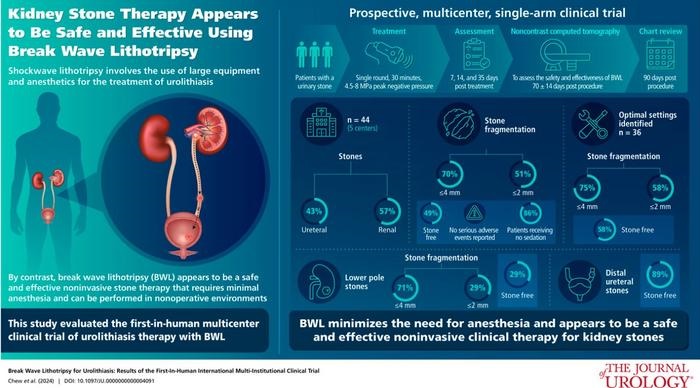Noninvasive Ultrasound Technology Provides Effective Treatment for Urinary Stones
Posted on 12 Sep 2024
Urinary stones are a common medical issue and a frequent cause of emergency department (ED) visits. Treatment options typically include surgery, such as ureteroscopy, or extracorporeal shockwave lithotripsy (SWL), a noninvasive method that uses high-pressure ultrasound waves to break up stones so they can pass naturally through the urinary system. While SWL is effective and noninvasive, it has drawbacks, including the need for large, expensive equipment and anesthesia, often requiring a surgical setting. Now, a noninvasive ultrasound technology called Break Wave™ Lithotripsy (BWL) offers a safer, more convenient alternative for treating urinary stones.
Unlike shockwaves, BWL uses low-pressure ultrasound waves to fragment urinary stones. This approach is delivered via a smaller, more affordable mobile unit, allowing the procedure to be performed in various settings outside of the operating room. In 2022, the BWL system received Breakthrough Device Designation from the U.S. Food and Drug Administration. The "first-in-human" clinical trial of BWL was conducted at the University of British Columbia (Vancouver, Canada) and included 44 patients across five hospitals in North America with stones located in the kidney (57%) or ureter (43%). After discussing alternatives like ureteroscopy or SWL, patients opted for BWL. Stones were targeted and treated for 30 minutes using real-time ultrasound imaging.

According to the results of this clinical trial published in The Journal of Urology, BWL demonstrated effectiveness, with 88% of patients showing evidence of stone fragmentation. Following treatment, most patients had fragments small enough to pass naturally: 70% had fragments measuring four millimeters or less, and 51% had fragments of two millimeters or less. Follow-up CT scans revealed that 49% of patients were completely stone-free. After adjusting the ultrasound dose settings, 36 patients were treated with an "optimized" approach, achieving a 92% fragmentation rate. In this group, 75% had fragments no larger than four millimeters, and 58% were stone-free.
As anticipated, success rates were higher for patients with stones in the distal ureter compared to those with stones in the lower pole of the kidney. Complications were generally mild, with no serious adverse events reported. Over a 90-day follow-up period, only 7% of patients required further treatment for the original stone. Most patients underwent BWL without the need for anesthesia, using either no medications or just mild pain relievers. In four cases involving severe, acute pain, BWL was successfully performed in the ED. This initial clinical study indicates that BWL is a safe and effective new treatment option for urinary stones. The procedure can be conveniently conducted in various settings, including the ED or a medical office, without the need for anesthesia or sedation.
"In this initial experience, BWL provided a high treatment success rate, using a portable technology that can be used in a range of settings, without the need for anesthesia" comments lead author Ben H. Chew, MD, MSc, of the University of British Columbia. “The BWL technique – together with other developing technologies such as ultrasonic propulsion – has the potential to provide effective, noninvasive treatment for patients with kidney and ureteral stones, reducing resource burdens and enabling more timely care."
Related Links:
University of British Columbia














